Little 4- year old “Sally” is in constant movement, hard for
her to sit still in circle time, cannot wait in line, seems to “bump” into
friends, interrupts and grabs things a lot. She seems to be a bundle of
immediate gratification; a whirlwind of activity always on the go.
What is driving Sally to be on the move? What it is NOT is bad manners!!
Children like Sally are typically always on the go because
they do not have a body sense of where they are in space so they are constantly
moving to find that space—somewhere.
What is body in space?
It is a sensory processing awareness skill that literally lets us all
know “what end is up”. Think of yourself
as living in a gravity free zone all the time and not knowing if you are right
side up or upside down.
Life for these children is a constant searching for a
sensory anchor that they see but cannot catch onto. Often these children become very anxious and
manifest that anxiety by using extraordinary loud voices, overtly seeming to be
aggressive and ignoring the “rules”.
None of this is usually the case.
However, herein lies the conundrum: these children need
boundaries and structure and at the same time they have difficulty processing
directions because of their internal chaos.
To understand these children one must first understand that
it is their neurology that is driving them.
Inside everyone’s head going from the outer ear way in is something
called our Vestibular System. It registers movement, touch, pain and body
righting and mediates and processes most of all our sensations. When this is not fully communicating with the
rest of our body several things can occur.
Some people experience tinnitus (a ringing in the ear that does not
stop), positional disorientation (being dizzy when moving so children keep
moving to try to stop the reaction or resist moving at all), inability to
visually focus at the midline of the body (“look at me”; “keep your eyes on
your paper”, etc.), poor balance etc. In
addition their ability to accurately motor plan in both fine and gross motor
arenas can be impacted.
It is important to keep in mind that not all children in
constant movement are ADD/ADHD. Sensory
impaired children also exhibit this need to move and have no attention issues.
So what can
teachers do to address this child’s needs and to reduce classroom chaos? (a partial list of suggestions)
- Have sensory centers in the room, things to touch, smell, manipulate, ride on, etc.
- Set a timer so that the child knows that when they feel the need to go to sensory center they have a specific time to be in there—limits help provide structure that these children have a difficult time understanding.
- Body charts –each time they use a good voice, keep their hands to themselves, sit nicely in circle time, etc. they get to put a “dot” on the body part they controlled and the object is to get a dot in each part everyday. (using Velcro dots makes these body charts re-useable and you can even use a photograph for the face so the child relates the dots not just to self control but personally to themselves as well).
- Go crazy times” in the classroom –“OK when the bell rings move ______(fast/slow/up/down, etc.) and when the bell rings again, stop”. Use these movements “breaks” throughout the day they do not have to last more than a minute!
- Use hula hoops to give visuals for “personal space” in circle time—smaller hula hoops are perfect for this and every child sits inside their hoop. Inside their hoop can be a squishy pad to sit on, or a doll to hold or a fidget as well to help sustain attention.
What can parents do at home to help their constantly moving
bundle of love? Much the same as what
the teachers do in school just adapted to the home environment. But a huge
suggestion is to turn off, tune off and
tone down the noise in the house. Electronics, the TV, computers are always
good “babysitters” but children today are not learning to amuse themselves
because the gadgets do it for them.
Research has unequivocally proven that children and adults
who spend a lot of time with electronics actually experience a form of “mental
addiction” to these devices. Additionally, research has shown that we are
developing something called the “popcorn brain”—it has to happen fast and
change even faster to keep our attention.
In an article by Dr.
Elizabeth Cohen further describes this phenomenon. “…according
to a recent article by Elizabeth Cohen, Senior Medical Correspondent for
CNN, we can forget how to read human emotions when we are always communicating
online. In
addition, constant stimulation can activate dopamine cells in a part of the
brain responsible for pleasure. Repeated, long-term stimulation can
actually alter the structure of the brain …Cohen spoke to David Levy, (a
professor with the Information School at the University of Washington) who said that a “popcorn brain” is a brain so accustomed to the
constant stimulation of electronic multi-tasking that it’s difficult to live
life offline, where the pace is much slower.”
Life
is movement and moving is part of life. Life is also knowing when to go and
when to stop. Some of children need a little more help than others in learning
the when and how of this. Learning to use our sensory system to make sense of
our world is a life long process starting with learning where we are and where
we want to go.
